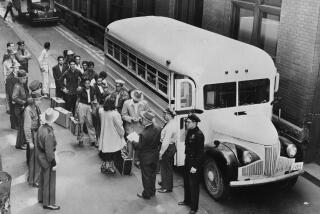Confederate plaque in San Diego has history of controversy, repeated removals
Once again, a plaque honoring Jefferson Davis, the president of the Confederacy, has been removed from the park at Horton Plaza.
The sudden move Wednesday morning by the city of San Diego came nearly 71 years after it was taken down the first time — shortly after the plaque was installed amid considerable civic controversy.
Back then, the impetus came from a group of Union Army veterans who, backed by a series of front-page newspaper articles, petitioned the City Council to get rid of the monument in the heart of downtown San Diego.
This time, it was another petition drive and a flurry of social media activity, texts from a state assemblywoman and a quick order by the mayor. It was over and done before most people knew what happened.
Without any fanfare, a city works crew removed the plaque from the ground in the downtown park at about 8:30 a.m. on Wednesday.
“This morning I ordered the immediate removal of a plaque honoring the Confederacy at Horton Plaza Park,” Mayor Kevin Faulconer said Wednesday. “San Diegans stand together against Confederate symbols of division.”
The move was similar to hurried actions around the nation, where cities took down Confederate statues in the wake of the violent, white supremacist rally in Charlottesville, Va., on Saturday.
The San Diego plaque was once on a large obelisk, but was reduced in size and stature decades ago. It specifically honored Jefferson Davis Highway, a planned transcontinental road that was to extend from Virginia to California.
The first time a Jefferson Davis plaque was removed from the plaza was in 1926 after a group of Union Army Civil War veterans protested that it was improper to honor the Confederate president. It had been in the plaza for less than a year.
According to the text on the plaque, it was first presented to San Diego on May 12, 1926 by a state chapter of the United Daughters of the Confederacy (California sided with the Union). The plaque was replaced 30 years later.
This week another petition was launched on Change.org, but before it took hold, the city acted.
“When I heard about the plaque, I texted Councilman (Chris) Ward and the mayor and it was removed within a few hours. Glad it’s done,” Assemblywoman Lorena Gonzalez Fletcher, D-San Diego, said on Wednesday.
In 2016, Gonzalez Fletcher pushed for Robert E. Lee Elementary School in Paradise Hills to be renamed to no longer honor the Confederate Army general. It is now known as Pacific View Leadership Academy.
City Councilman Ward, whose district includes downtown, also praised the Wednesday removal of the Horton Plaza plaque.
“Monuments to bigotry have no place in San Diego. Thank you to the citizens of San Diego who highlighted this, and to City staff for their quick response to remove this symbol of hate,” Ward said on Facebook.
Ward added in a later statement: “This is a small but critically important step to ensure San Diego remains a safe and inclusive place, and we will continue to confront the symbols and ideology of white supremacy and Neo-Nazism that threaten the values that make our city and country great.”
Outrage over the white supremacists rally on Saturday in Charlottesville, which turned deadly when a man rammed into counter-protesters with his car, reverberated nationwide. People had initially assembled in Virginia because they were upset about the removal of a statue Lee.
President Donald Trump said that both the protesters in Charlottesville — a group of neo-Nazis, Ku Klux Klan members, anti-Semites, and other white supremacists — as well as the coutner-protesters, were to blame for the violence. His view has been denounced for days by politicians across the political spectrum. On Wednesday, members of the U.S. Joint Chiefs of Staff issued statements condemning racial bigotry and extremism.
Some cities across the country had been removing Confederate statues, memorials and symbols — or debating whether to do so — in recent years.
But the process seemed to accelerate after Charlottesville, with the removal of statues in various jurisdictions. Many, like San Diego, did so with little, if any, advance notification, in order to avoid chaos like in Virginia. Clearly officials wanted to avoid any demonstrations similar to what happened in Charlottesville.
While it took just a few hours to remove the plaque at Horton Plaza, some efforts in other cities were more elaborate. Tuesday night, Baltimore removed metal statues that were so large that heavy equipment was needed. That city’s politicians voted to remove the statues after a public vote and debate days earlier. At 3 a.m. in Los Angeles, workers used a backhoe to remove a 6-foot monument to Confederate veterans from the Hollywood Forever Cemetery.
A catalog of Confederate place names and symbols in public spaces by the Southern Poverty Law Center, a civil rights organization that tracks hate groups, has 1,503 entries including 718 monuments and statues and 109 schools named after Confederates — mostly in the South.
The center’s list is not exhaustive. It did not, for example, include the Davis plaque in Horton Plaza.
There were two waves where construction and dedication of monuments, schools and other honors for Confederates surged, the center said. The first was around 1900 to about 1920 when Jim Crow laws were enacted. The second was in the 1950s and 1960s during the Civil Rights movement when advocated pushed governments and courts to repeal laws that discriminated and harmed people based on race.
The law center takes issue with the argument that memorializing Confederate figures represents nothing more than history.
“Rather, it ignores the near-universal heritage of African Americans whose ancestors were enslaved by the millions in the South,” the center said. “It trivializes their pain, their history and their concerns about racism — whether it’s the racism of the past or that of today.”
The group’s research also found that there have been at least 100 attempts to remove or alter symbols of the Confederacy.
The San Diego plaque has been controversial since it first appeared.
There were no Civil War battles in San Diego, but the city, its harbor, and proximity to Mexico, had strategic value to both sides. Southern California also had a reputation as a hotbed for Confederate sympathizers, so to keep the harbor in the Republic’s control, San Diego was reinforced with supplemental Union troops and artillery.
The United Daughters of the Confederacy supported memorials to denote Jefferson Davis Highway in cities along the route across the country, but in 1926 in San Diego, the situation had another twist that became a local dispute. One of the movers and shakers in the town was attorney W. Jefferson Davis, a distant relative of the Confederate president. The attorney Davis underwrote the granite block that held the original plaque.
San Diego’s Davis also happened to be a champion of highway infrastructure, and the plaque commemorating the highway once mentioned him by name and his rank in the U.S. Army, in which he served around World War I. It annoyed some politicians who felt he was unworthy of such an honor.
One city councilman, Don Stewart, was among them.
“‘I offer $1000 for the privilege of erecting a monument to myself in the plaza,’ bid Councilman Stewart, with mingled humor and irony,” according to a front-page article in The San Diego Union on July 13, 1926. Stewart also called the plaza, which had similar memorials, a “tombstone for living dead.”
The Grand Army of the Republic, a group for veterans of the Union Army, also wanted the plaque removed for bearing President Davis’ name. On July 20, 1926 they passed a resolution that “requests the honorable city council and the park commission of the city of San Diego to order the removal from the plaza of the obnoxious obstruction.” The text of their resolution appeared, in part, in the July 21 edition of The San Diego Union.
Apparently the Union veterans got their wish. Months later, the plaque was removed and the Daughters of the Confederacy and the Jefferson Davis Highway Committee protested.
“Mr. Davis has no knowledge of the wording of any tablet on the monument. The marker itself was a gift from him to our organization, as he expressed it, in memory of his mother, the greater part of whose life had been devoted to work in connection with local and state organizations of the United Daughters of the Confederacy,” the group said in a statement printed in a November, 1926 Union article.
It’s unclear why the memorial to Jefferson Davis Highway was rededicated 30 years later, but when it returned, it made no reference to attorney Davis. The timing coincides with the second wave of memorials to Confederate figures noted by the Southern Poverty Law Center.
(The plaque was temporarily removed in 2014 when renovations began on the park, and was returned when it opened last year.)
A spokesman for the mayor said there were 10 hearing on the park renovation but no controversy over the plaque. The city will try and return it to the United Daughters of the Confederacy, the plaque’s original benefactors.
Staff writer Roger Showley contributed to this report.
Twitter: @jptstewart
joshua.stewart@sduniontribune.com
(619) 293-1841
More to Read
Sign up for Essential California
The most important California stories and recommendations in your inbox every morning.
You may occasionally receive promotional content from the Los Angeles Times.











